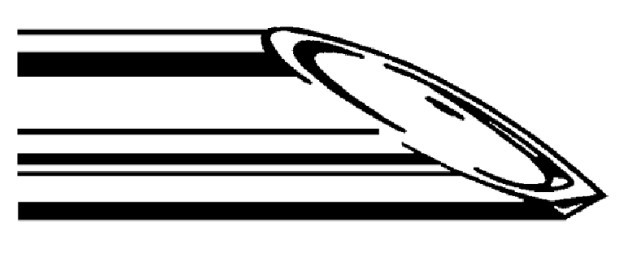To give a sub-Q injection lift the skin between thumb and finger so that it forms a little tent....there should be two long sides pointing at the animals head, and a third (flat) side at the rump end. Think of it like a persons nose...how the bridge makes a point towards the forehead, and the bottom, where the nostrils are, are the flat part. You want to stick the needle in the flat part. Also...the bevel of the needle should always face up...so that you lead with the very tip of the needle. If you point it down often you will lead with the flat of the bevel and it will be much harder to puncture the skin.

Example of the bevel held up.
Also...when you tent the skin...if the "nose" is pointing at the rump, side, whatever it's not a big deal...just hit the flat and you'll be fine. Always draw back on the plunger after you have the needle in...if you get blood flash back into the syringe DO NOT INJECT, pull out and try again. I've never had that happen (in 11 years of working with animals) but there is always that ONE time you miss just enough...sink it in a vein...and end up killing the animal. This is more of an issue for IM injections then Sub-Q, but it's always a safe practice. If you end up puncturing through both layers of skin (so you are no longer in the skin) when you draw back on the plunger the syringe will fill with air...STOP....pull out and try again (after you bleed the air out of the syringe). Nothing worse then getting in a hurry and squirting the medicine all over the outside of the animal.
Just a note also...animals have less nerve endings in their skin then humans. So they tend to feel less pain then humans. So as long as you are using nice sharp needles the animal will more then likely experience little to no pain. Most animals react more to cold solution then they do the actual needle stick.

Example of the bevel held up.
Also...when you tent the skin...if the "nose" is pointing at the rump, side, whatever it's not a big deal...just hit the flat and you'll be fine. Always draw back on the plunger after you have the needle in...if you get blood flash back into the syringe DO NOT INJECT, pull out and try again. I've never had that happen (in 11 years of working with animals) but there is always that ONE time you miss just enough...sink it in a vein...and end up killing the animal. This is more of an issue for IM injections then Sub-Q, but it's always a safe practice. If you end up puncturing through both layers of skin (so you are no longer in the skin) when you draw back on the plunger the syringe will fill with air...STOP....pull out and try again (after you bleed the air out of the syringe). Nothing worse then getting in a hurry and squirting the medicine all over the outside of the animal.
Just a note also...animals have less nerve endings in their skin then humans. So they tend to feel less pain then humans. So as long as you are using nice sharp needles the animal will more then likely experience little to no pain. Most animals react more to cold solution then they do the actual needle stick.















